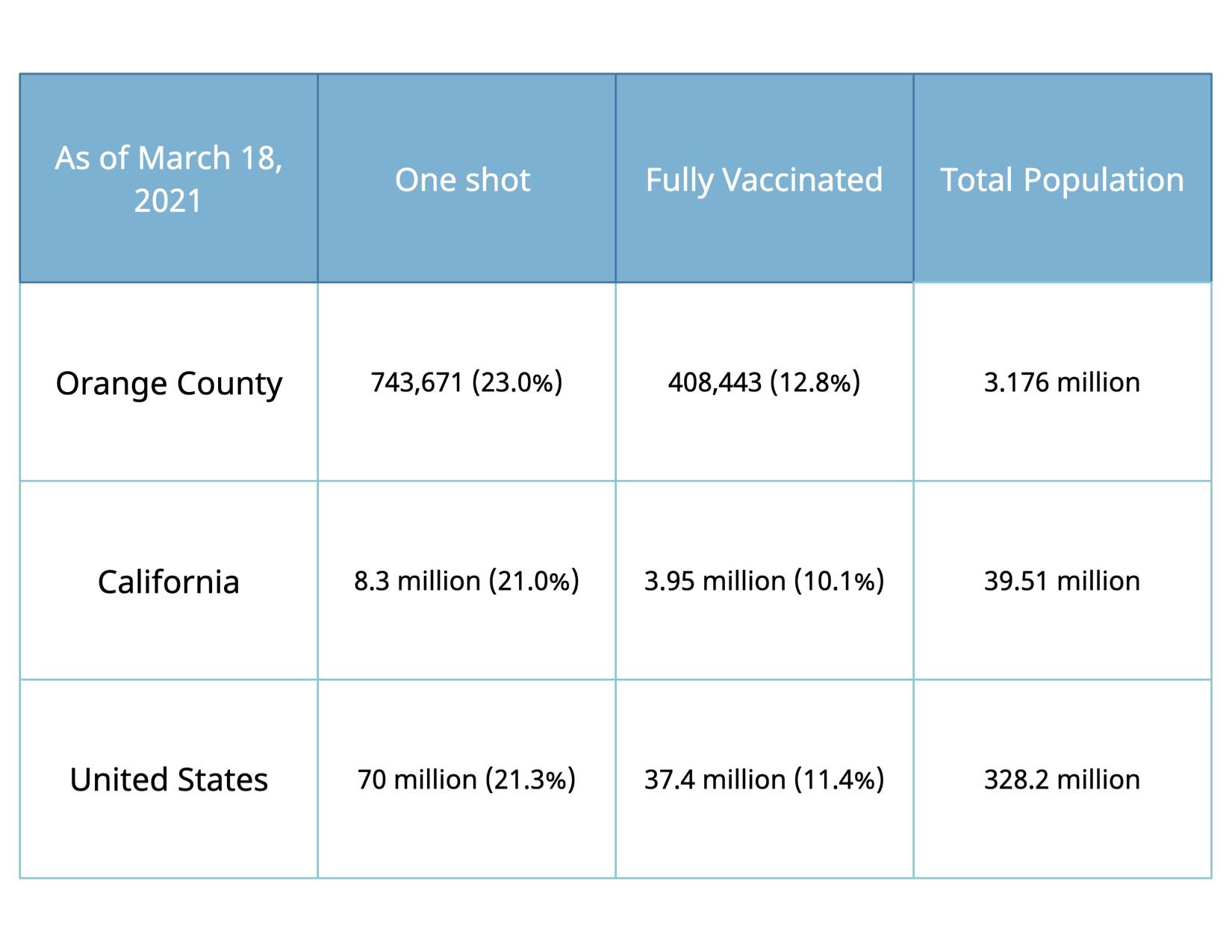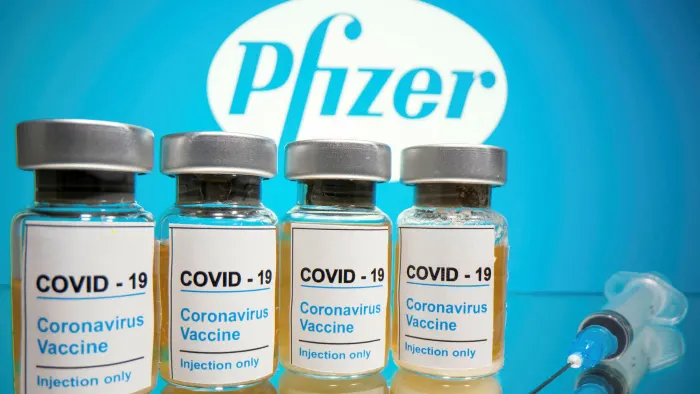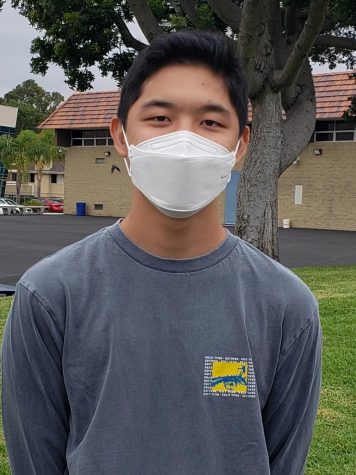Behind the Business: Vaccines
March 26, 2021
Some might still remember when the novel “coronavirus” was the popular subject of jokes and TikTok videos, a disease no one knew or really cared about in America. Now, it has claimed the lives of over half a million U.S. citizens, and we have only recently seen a decline in case numbers after a peak in January. On March 11, 2021, we “celebrated” the official anniversary of COVID-19’s status as a global pandemic. All of the struggles and adversity that this nation and the world have had to overcome has been immense – but we already know that. What many actually want to know now is not how far we have come, but how much farther we need to go.
First and foremost, we can examine our own state of California. Currently, the state has just started Phase 1C, the third component of the first vaccine phase. This first phase consists of Phase 1A, Phase 1B, and now Phase 1C. After this, California will move on to the second phase, one that has yet to be fully detailed. We have already vaccinated the majority of our healthcare workers in Phase 1A earlier this year and have also distributed vaccinations to most in Phase 1B, which primarily focused on the elderly (age 65 and older), educators, emergency workers, and those in the food and agriculture sectors. Additionally, we have just started Phase 1C, which addresses anyone between ages 16 and 64 with underlying health conditions. At a later determined date, Phase 1C will move towards vaccinating those over the age of 50 and workers in other sectors that are more prone to COVID-19 transmission.
It is a promising sign that California has nearly completed the first phase. However, the second phase is expected to be the largest and most time-consuming part of the process, given that it will deal with anyone up to the age of 64 without any underlying health conditions – the majority of people living in California. This second phase will be conducted on an age-based priority system that has yet to be truly detailed in full.
Now that all the phases have been outlined, it is important to examine local, statewide, and national statistics.

Statistics offer scientific clarity and phases simplify complex production and distribution processes into digestible steps. However, medical experts have also offered their opinions on how things are going currently, and more importantly, what we will look like several months from now. During a New York Times interview, Dr. Anthony Fauci, Chief Medical Advisor to the President, stated in regards to herd immunity (the reduced chance of spread to non-vaccinated individuals and individuals in general as a result of overall vaccination numbers), “I think the real range is somewhere between 70 to 90 percent [vaccinated].” He also addressed when high school students would most likely be vaccinated, stating, “we anticipate data on high school-aged individuals, namely individuals 12 to 17 years old, by the beginning of fall.” He later added that elementary school students are expected to be vaccinated at a much later date, likely following high schoolers in 2022.
Many have felt that not enough is being done to distribute vaccinations and that even when administered, the process has often been chaotic and disorganized. According to an opinion poll conducted by Monmouth University, 22% of participating individuals are somewhat dissatisfied with the rollout of vaccines, and 13% are very dissatisfied. Harvard Research Fellow Stephen Kissler stated that, “rapid COVID-19 tests could help life return to normal in the U.S. but that regulatory issues are getting in the way. Most rapid tests are only available with a prescription.” It seems like the age-old impediment of bureaucracy has arisen once again, as vaccine distribution rates have been slowed by the need for extensive paperwork, vaccination financial discussions, and government-authorized green lights. However, it is worth acknowledging that vaccine distribution rates have far exceeded the original expectations laid out by Operation Warp Speed, which was conceptualized in March of 2020. It was originally estimated that it would take 10 years to vaccinate every individual in the US. Now, it might only take a fifth of that time.
Additionally, much of the COVID-19 research and progress has been left in the hands of private corporations who are acting more out of personal interest or financial gain than humanitarianism. Despite the climbing death toll of the virus, Pfizer executives have recently stressed how much more lucrative this “business model” could get. Pfizer CFO Frank D’Amelio has stated, as cited by The Intercept, “we think as this shifts from epidemic to endemic, we think there’s [financial] opportunity here for us,” as well as stating how the company could, “take advantage of opportunities from a demand and pricing perspective.” These statements were made during a Barclays Global Healthcare Conference over Zoom as an assurance to investors that Pfizer’s foreseeable future is one of exponential profit. Whether one sees this as classic American capitalism at play or rather a sickening marginalization of human life statistics in favor of monetary gain is up to the reader. However it is slightly disturbing how much disregard such statements seem to have for the American compared to the American dollar. Business is business as always, but should it really be business when providing a nationwide health service that has the potential to save the lives of millions?
Johnson & Johnson and Moderna have also quietly assured behind-the-scenes that they plan to raise vaccine prices in the near future as well. Executives such as D’Amelio have voiced how a change in the medical environment could reap major rewards for pharmaceutical companies. Many experts are already discussing how COVID-19 could become a perennial issue similar to the flu. One might see how this could be constructed into a major business venture for vaccine producers who read indefinite endemic as unlimited financial gain.
Now, that is not to say that companies such as Pfizer and Johnson & Johnson should not be praised for their medical breakthroughs, but rather, Americans need to understand that Pfizer and other vaccine producers are not acting purely out of goodwill. It is remarkable how far this nation has come in terms of progress regarding COVID-19, and many of these same companies have suspended ordinary market pricing for vaccines in order to help ease the burden on overcoming the global pandemic. There might even be positives to draw from the mass corporatization of vaccines, as competition between these companies could push each other to produce more rapidly, research more intensively, and maintain reasonable pricing in order to produce the optimal vaccine product that has the edge over other available ones. However, it might be important to note that it becomes somewhat unclear as to whether these companies are working tirelessly to aid the American people or working towards a future of price hiking until vaccines reach a point of unaffordability? The answer is most likely a bit of both, but that distinction has to be made first. Turning to the future, it is doubtful that these companies are looking to maintain a constant and reasonable price instead of seeking whatever kind of upward financial projection they can make possible.
“Business is business as always, but should it really be business when providing a nationwide health service that has the potential to save millions of lives?”
One must point as to the messiness or moral ambiguity to the tackling of the global pandemic is tied to various anti-vaccine groups’ hesitation about possible side effects. In a recent poll
conducted by Kaiser, 68% of respondents said that the vaccine’s effects are unknown, 59% worry about serious side effects, 55% believe the vaccines are not as safe as they are said to be, and 31% think they might get COVID-19 from the actual vaccine. These numbers are alarming and could undermine the progress being made in vaccine distribution. False rumors, trumped-up claims, and conspiracy theories regarding the vaccine have made their rounds across the internet, conversations, and protests around the nation.
Two main forms of lies have been consistently spread amongst the anti-vaccine community, those being false linkages between someone receiving a vaccine and their soon untimely death and side-effect rumors such as the vaccine’s potential to cause infertility, a classic in the anti-vax handbook. One doctor refuting such claims, Paul Offit, dryly remarked “[An individual] gets the vaccine. Two weeks later he dies of a stroke. Why? Because he was in his late 80s, and people in their late 80s can die of strokes. The vaccine doesn’t make you immortal.” It should be clear at this point that the vaccine does not cause infertility, nor is linkable to premature death, nor trauma or any concoction of the above. Health officials have made it clear that there have been zero common side effects that have been recorded amongst the millions of individuals who received a shot, save a few, incredibly rare cases of anaphylactic shock, as cited by WebMD. However, many have claimed to have experienced short-term side effects like fatigue. Americans should certainly not be unsure about whether or not to receive a vaccination, and surely 59% of them should not be concerned about potential side effects. Despite this, the anti-vaccine movement marches forward today and tomorrow and likely for many years to come, sabotaging the work of healthcare officials, doctors, and vaccine distributors who work tirelessly to protect many individuals who do not even care enough to wear a mask for their own and others’ personal safety.
As such, the vaccine distribution process has at times been messy, financially incentivized, or undermined by the anti-vaccine community. There are many ways in which this virus has been perpetuated by viruses of other natures; of greed, of ignorance, of lies. Sometimes it is hard to be a patiently waiting American, a dutiful mask-wearer, an individual who trusts that these roadblocks and obstacles will wane over time as the vaccine prevails. However, the light at the end of the tunnel is approaching. We have looked back at a year of loss and of tragedy, but for the first time since the pandemic started, we can say that we can look forward to a future worth standing up for. That future seemed miles away only a few months ago, but now we have the key to the door, that key being widespread access to vaccination.





